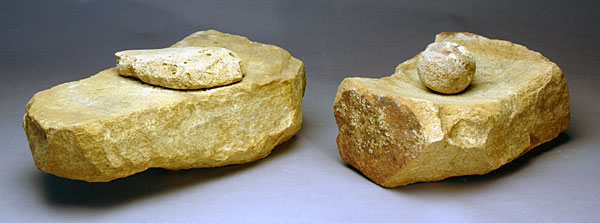- Home
- The town and the abbey
- Before Saint-Denis
- A hoard of quern-stones
Quern-stones with handstone and pestle. © UASD / J. Mangin.
To grind wheat, Neolithic people used large, flat stones, known as quern-stones, against which they would crush the grain with handstones-smaller stones with an oblong shape. A hoard of five such quern-stones was found in the waste pit of a house being excavated in La Plaine. The objects associated with the hoard are characteristic of the "Villeneuve-Saint-Germain"culture. The stones were found with their flat sides facing downwards. Two handstones and three round pestles completed the hoard. Both the quern-stones and the handstones were sandstone; the pestles were made of sandstone, quartzite and flint.
A macroscopic study of the quern-stones' surfaces revealed several phases of use and upkeep. Two of the stones-whose surfaces had been prepared with more or less careful picking and grinding-showed few signs of use; on the other hand, examination of the three other stones revealed two distinct phases: a polishing phase resulting from the back-and-forth movement of the handstones used to crush the grain, as well as a bowl-shaped wear pattern caused by a steady, circular percussive movement of the pestles, no doubt linked to a different type of grinding.
From the second century BCE onwards, the use of millstones became widespread. This type of mill is formed by two superimposed cylinders, the lower one fitted with a central shaft, and the upper one equipped with a handle that allowed it to be turned.

